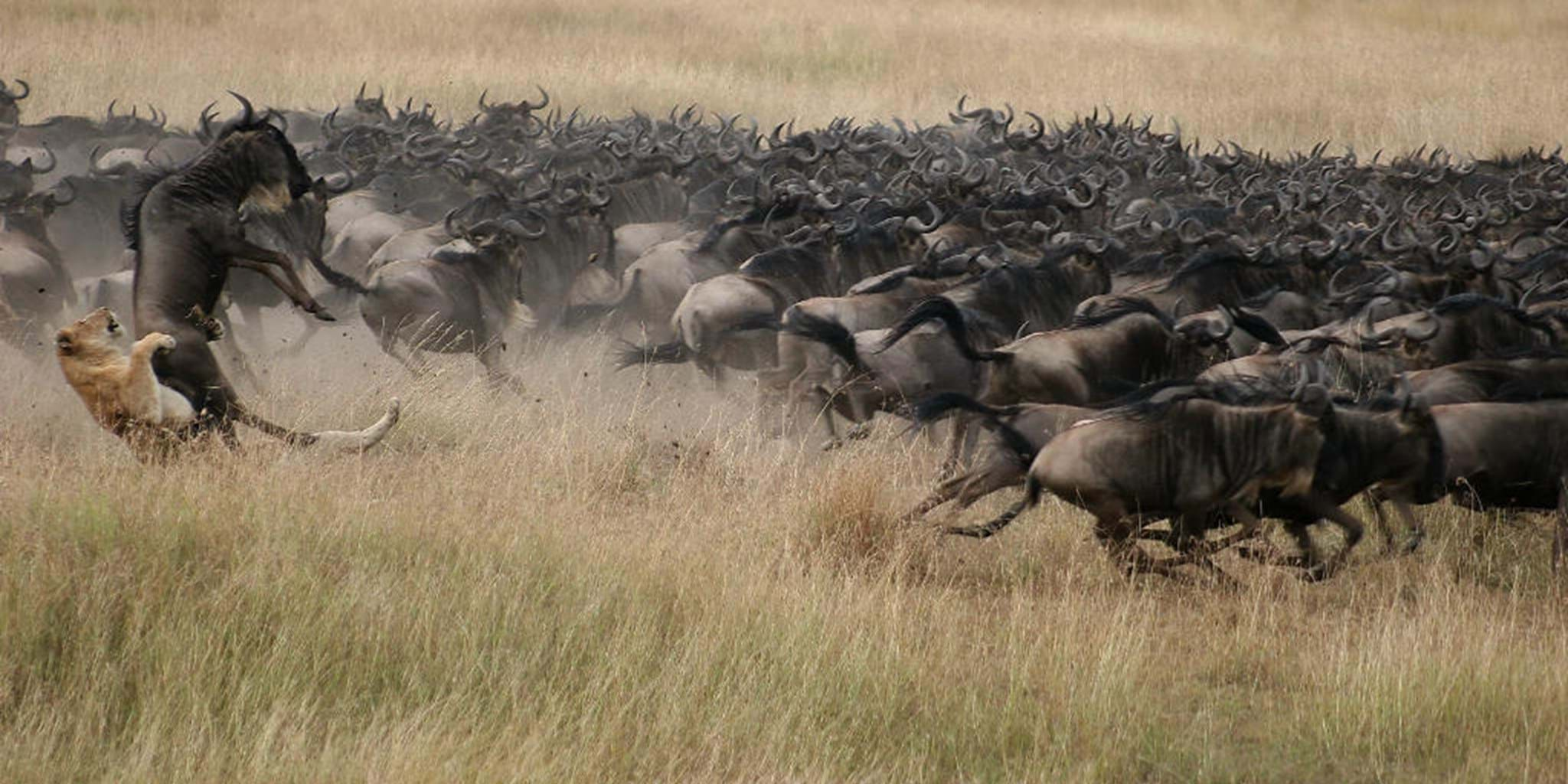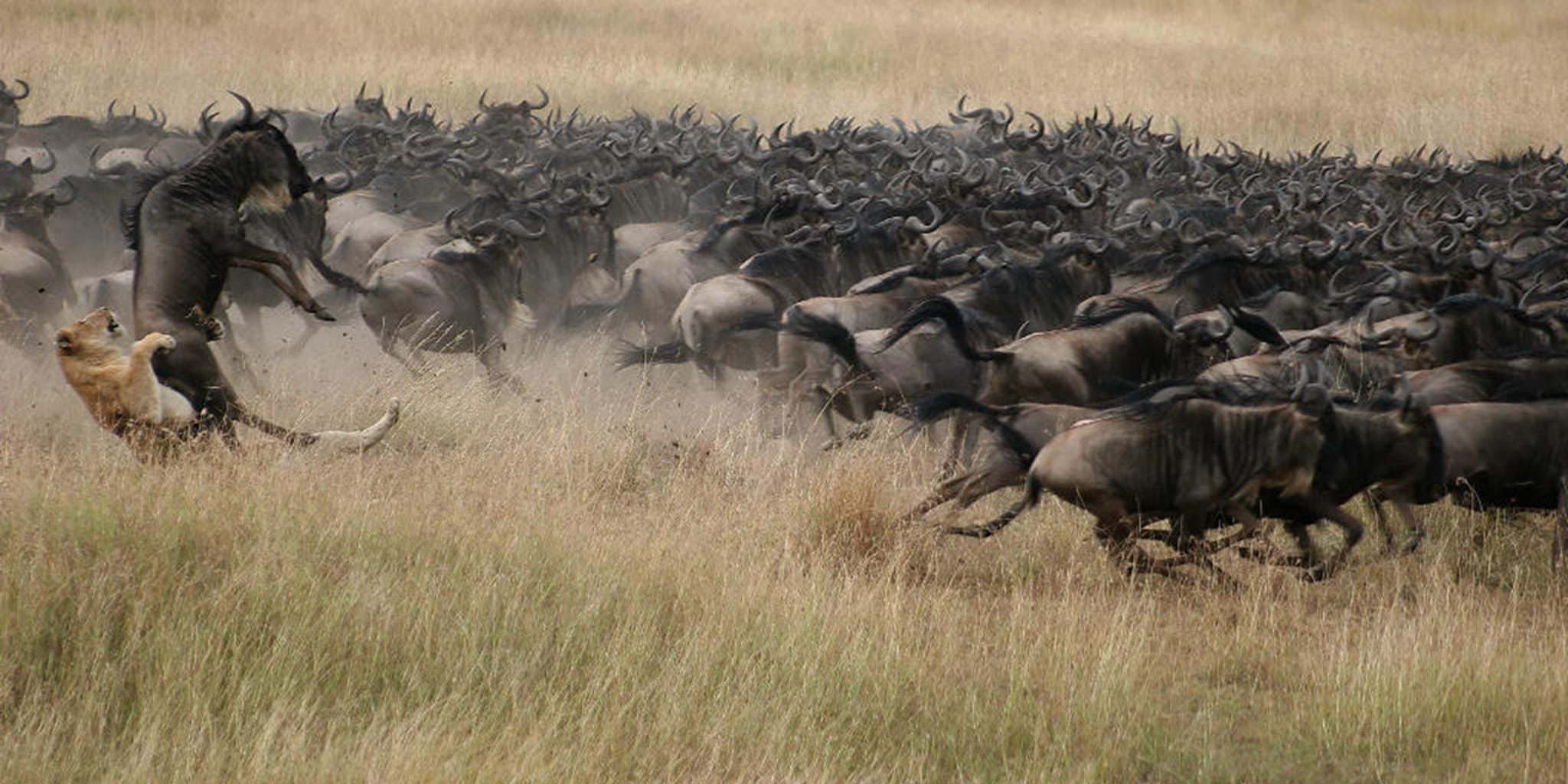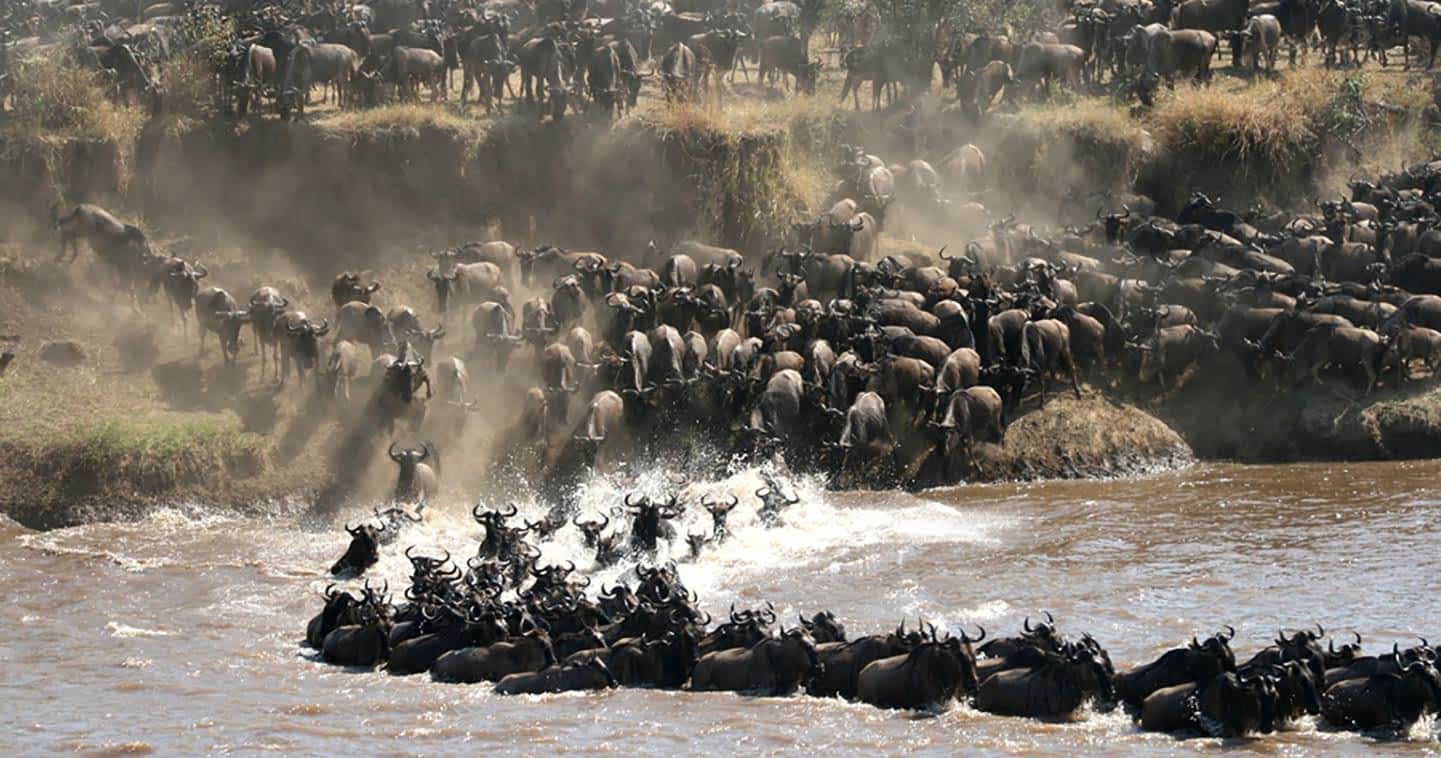The Great Wildebeest Migration
The great wildebeest migration is one of the most remarkable natural spectacles in the world which is recognized as one of the Seven Wonders of the Natural World and can only be witnessed in Africa mainly in Masaai Mara national reserve in Kenya and Serengeti National park in Tanzania. This phenomenal migration is one of the most sought and photographed wildlife extravaganza which attracts humans and other different species due to its cyclic movement making it worth witnessing because of the unique view of diverse animal species in the circular migration in search for fresh greener pastures and water since they are obligate drinkers.
What are Wildebeests?
Wildebeests are also known as Gnus and they belong to the family of Bovidae which includes true antelopes, cattle, goats, sheep, and other even-toed horned ungulates. Wildebeests are classified as antelopes of Genus Connochaetes. There are two species of wildebeests, with one being the black wildebeests or white-tailed gnu and the other being the blue wildebeests or brindled gnu which are both northern and southern species however in East Africa, the blue wildebeests are the most abundant ones with the most migratory population. The wildebeests possess what is known as swarm intelligence which enables them to systematically explore and overcome an obstacle as one, especially during the great migration

What is the Great Wildebeest Migration?
The great wildebeest migration is the greatest long-distance animal migration in the world where more than 1.5 million wildebeests migrate in a boundless loop along with zebras, gazelles, and other animals across Kenya in the Maasai Mara national reserves ecosystem and Tanzania in Serengeti national park plains following the annual rainfall pattern and grass growth in search for fresh greener pastures particularly that contain high phosphorus levels and water however the timing of their migration in both dry and rainy season can vary considerably from year to year. Wildebeests can cover a distance of approximately 800-1000km during their migration along age-old migration routes.
Why do wildebeests migrate every year?
Wildebeests migrate mainly in search of food to survive whereby as the water and food sources diminish, they follow the annual seasonal rainfall pattern looking for better fresh greener grass which contains high phosphorus and water crossing from Maasai Mara’s ecosystem to Serengeti national park’s plains. Wildebeests migrate every year not only in search of fresh greener pastures and water but also to feed their calves and make them stronger.

Where the Great Wildebeest Migration takes place.
The Great Wildebeest migration takes place in only two protected National parks found in two East African countries whereby the great migration can be witnessed only in Maasai Mara national reserve found in Kenya and Serengeti national park found in Tanzania. Wildebeests move in a clockwise loop from Serengeti northwards into the adjoining Maasai Mara national reserve.
The best place to see the Great Wildebeest Migration
The best place to witness the great Wildebeest migration is Serengeti national park mainly in Ngorongoro conservation area which is found in the Southeast of Serengeti national park and the famous Ndutu plains which is situated in the center of the southern plains of Serengeti national park. Ndutu plains are also part of the North-western Ngoro Ngoro area. However Mara River found in Maasai Mara is also a wonderful spot to witness the great wildebeest migration because the river crossing of the wildebeests across Mara River is the climax of the journey filled with drama is the most exciting sightings of wildlife in East Africa.

What is the best time to see the Wildebeest Migration?
Despite the fact that the great wildebeest migration occurs all year round, there are months during the dry season which are proven to be the best time to witness the great migration. These months range from June-October however July, August and September are considered the best because the chances of witnessing large herds of wildebeests river crossing is very high since that’s when animals move into Maasai Mara in Kenya. During the dry season, there is high animal concentrations around rivers and waterholes hence they are easily spotted.
How much does it cost to see the Great Wildebeest Migration?
The cost of seeing the great wildebeest migration depends on the place where a tourist prefers because the costs are different whereby in Maasai Mara, the cost is $450 per person per day while in Serengeti, the cost is $400 per person per day.
What happens during the great wildebeest migration?
During the great wildebeest migration, large herds of over one million wildebeests after calving in the southeast of Ngoro Ngoro area in Serengeti national park move along with other wild animals mostly Zebras and Gazelles in a clockwise direction across Serengeti’s ecosystem towards Maasai Mara in Kenya. During the migration, wildebeests are grazing in fresh green savannah and open plains, mating and calving their young ones.
How long does the great wildebeest migration take?
The great wildebeest migration takes place throughout the year however the period of time it takes varies between the Serengeti plains and Maasai Mara’s ecosystem. The migration is more active in Serengeti national park for over 9 months and were was active in the Maasai Mara national reserve for only 3 months from August-October.
Why do Wildebeests migrate with zebras?
Wildebeests and Zebras have a great relationship since they benefit each other from feeding to protecting one another, especially during the great migration simply because Zebras have excellent eyesight during day and night which enables them to see predators earlier enough for them to escape, unlike wildebeests which have poor eyesight however wildebeests have a great sense of smell and hearing as well as a swarm intelligence which helps them to avoid and act upon danger during their migration. Zebras and wildebeests have unique grazing patterns of feeding on the same grass whereby zebras feed on the top parts of the grass which enables the wildebeests to feed on the short grass they usually prefer.

What to pack before going for the Wildebeest migration
There are certain useful things a tourist must have before going for the great Wildebeest migration safari namely:
Anti-malaria Pills
Tourists planning for a safari are highly advised to carry malaria pills with them for malaria prevention since there are high risks of malaria in some parts of the park like the streams and river banks that fill up, especially during the rainy season. Some can make appointments with doctors for malaria vaccination before going on a safari.
Binoculars
For a magnificent clear view of the Wildebeest herd along Zebras, Gazelles, and other wildlife species, you will need binoculars in order to observe the animals safely since you watch them from a distance. Binoculars offer a great game drive experience, especially during the great wildebeest migration.
Camera
Besides binoculars, tourists need to carry with them a camera especially the ones with big zoom lenses that can capture objects from a distance. Cameras are of great importance during a safari as they help in capturing all the best photos on your safari for future use.
Travel documents.
All international tourists are advised to move with their travel documents since African safaris sometimes involve crossing borders like the wildebeest safari, which involves crossing from Kenya to Tanzania hence authorities require travel documents like passports in order to be granted access to the country.
Torches.
It is important to carry a torch on a safari, especially for those who are going for night game drives as you will need light to have a clear view of the nocturnal animals since it gets darker at night.
Sun Screen.
Due to climatic changes Africa sometimes get sunny so you will need sunscreen mainly to protect your skin from the harmful rays of the sun since it reduces the overall UV exposure to the skin.
Warm Clothes.
There are temperature changes, especially in the national parks hence it gets colder, especially at night, Tourists are advised to pack enough warm clothes which are long-sleeved shirts and trousers to keep them warm. Not to forget a waterproof cloth or layer is as well useful during the rainy season.
Witnessing the great wildebeest migration in either Kenya or Tanzania is one of the best spectacles worth experiencing during your Safari in Africa.
For more info:
Email: [email protected]





